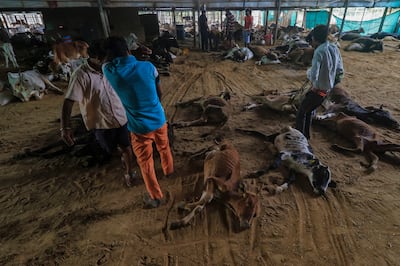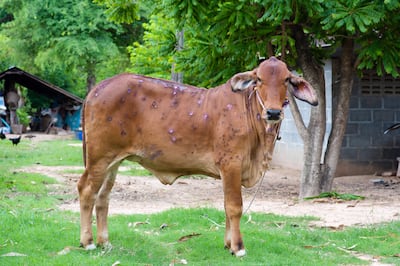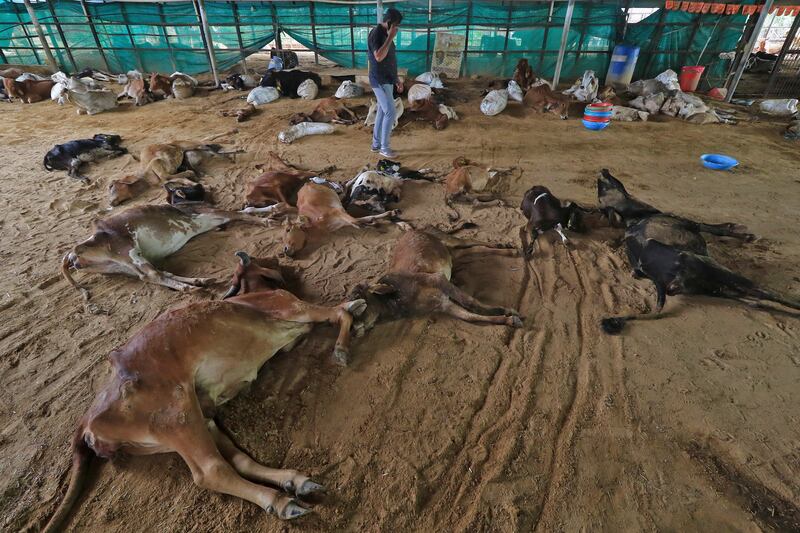Nearly 100,000 cows and buffaloes have died after more than two million cattle were infected by a virus in India in one of the deadliest outbreaks in the country.
Lumpy skin disease is threatening India’s 300 million cattle population. The disease, caused by a capripoxvirus, is transmitted by blood-feeding insects such as mosquitoes, ticks and flies
The outbreak was first reported in July in the western states of Rajasthan and Gujarat, and has since spread to more than 250 districts, the federal animal husbandry ministry said.
The highest number of deaths were reported in Rajasthan with nearly 65,000 cases, followed by northern Punjab and Gujarat—India’s leading milk-producing states.
The virus triggers causes lumps to grow under the skin before the nodes burst and turn into deep wounds that cause infections.
At Rajaram Gaushala Ashram in Banaskantha district of western Gujarat, more than 500 cows have died of the disease in the past two months.
“We had 5,300 cows in our shelter but about 1,000 of them got infected by the disease and half of them died,” Ram Ratan Das, who is in charge of a cow shelter, told The National.
“The wounds have maggots and we are cleaning and giving them medicine. It is heartbreaking to see them in pain. This is the first time that cows in our shelter have got such a disease.

Authorities have set up control rooms to monitor and engage in effective preventive initiatives across the country.
More than 10 million cattle have been vaccinated with a shot designed for a similar disease.
In Gurugram, a satellite city outside the capital Delhi, reported nearly 100 deaths and 900 cases of the infection in 24 hours.
The Delhi high court this week heard a petition and ordered authorities to take immediate remedial steps to eliminate the disease.
Veterinarians say incessant rains in parts of the country have triggered the viral outbreak, which thrives in those conditions.
Several parts of India recorded weeks of extreme heatwaves before the monsoon set in, with excess rainfall and flooding in parts, while others suffered drought.
'Grim' situation
Lumpy skin disease was first recorded in Namibia in 1929 and the first case in South Asia was detected in 2019 followed by a case in Maharashtra state.
“The situation is grim. While the mortality is not much, the morbidity is high and transmission is quite fast. After rainfall, we get a lot of vectors. We need to restrict the movement of the cattle,” Dr Vandana Gupta, an associate professor at Nanaji Deshmukh Veterinary Science University in Madhya Pradesh, told The National.
Dr Gupta also blamed the absence of a vaccine for the outbreak.
Prime minister Narendra Modi this month claimed that Indian scientists had developed an indigenous vaccine for lumpy skin disease. He said the shots would be available in a few months.
“It is spreading because we do not have the vaccine for LSD . … whatever we are using as a console manager, we don’t know how effective they are. The strains might be changing and we need to update the vaccine,” she said.

The disease outbreak is taking an economic toll on dairy farmers dealing with fatalities and decreased milk production.
India is among the world’s largest milk producers, with 22 per cent of global production, according to the UN’s Food and Agricultural Organisation.
Dairy is among the most significant agricultural contributors, accounting for 5 per cent of the country's economy and giving direct employment to more than 80 million people.
“About 15 to 20 villages have one veterinary doctor,” Chandrapal Singh, a farmer from Uttar Pradesh told a local newspaper. “They just asked us to create space between the cows. We had complained to the authorities, but it is of no use. In my village, about 30 cows have died. Milk production has come down.”






